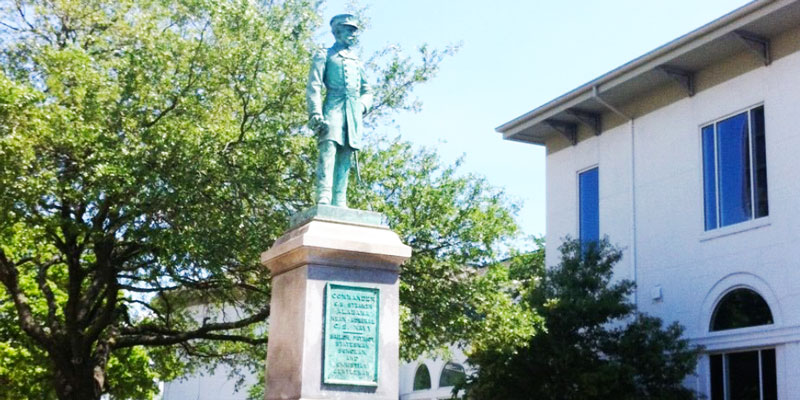June 26, 1900, had been a record-setting day in Mobile, dumping 12½ inches of rain in 12 hours. And stormy weather threatened again on the 27th.
But that did not stop thousands of people from showing up at the base of Government Street downtown to honor a local hero of the War Between the States, as the Civil War still was commonly called in the South. By 5 p.m., according to the Mobile Daily Register, an “immense crowd” that included ladies in “summer costumes and beautiful hats” ignored the “ugly black squall” to the east and filled out Royal Street and Duncan Place. They took up the sidewalks and galleries in the surrounding neighborhood.
In front of them sat a giant platform constructed for the unveiling of a bronze statue of Raphael Semmes, a Confederate admiral whom historians later would recognize as the most successful raider of commercial vessels in maritime history.
It is hard to imagine the scale of the presentation. Mayor J.C. Bush, city council members and other public officials sat on the left, while the late admiral’s daughter, Electra Semmes Colston, and other relatives sat on the right. The platform also housed the Semmes Camp No. 11 of the United Confederate Veterans and members of the press.
The Alabama National Guard looked on as the Excelsior Brass Brand banged out “Dixie” and other tunes as a prelude to the afternoon’s speeches. Dignitaries included Edward P. Allen, the Catholic bishop of Mobile, and William J. Samford, who at age 17 had commanded the 46th Alabama Infantry and was in the middle of campaigning for what would be a successful run for governor of Alabama.
The newspaper drew a military metaphor in its description of the proceedings in coverage that took up nearly the entire front page of the next day’s paper: “For about an hour, the dark nimbus clouds were marshalling their flames there, much as an army is marshalling in battle array.”
In his address — interrupted by rain but continued once the assemblage had taken cover indoors — Samford seemed not to consider that possibility that future generations of Mobilians and Alabamians would be any less enthusiastic about bronze-and-granite tributes to “our great men and women” during the noble cause.
“That posterity, failing to appreciate and perpetuate the worth of its ancestors, will itself leave for its posterity nothing worth preserving in marble,” he said.
The Daily Register, in a separate article, agreed, saying, “We shall not likely hear one word of criticism from any respectable quarter of the Union for the passions of war have subsided, and all observers are able to recognize in Semmes the highest form of patriotism a noble bravery, and a chivalry that would have done credit to the proudest knight of the middle ages.”
It should be noted that, in fact, high regard for Semmes was not unanimous. Putnam’s Magazine of New York wrote a scathing review of Semmes’ memoir a few years after the Civil War, concluding, “There never was a meaner, more ungallant enterprise than that of the ship-scuttling skipper of the British pirate Alabama.”
Contemporary controversies
Future generations, as well, very much did question the nobility of Semmes and other Confederate giants immortalized in bronze and marble in Mobile and throughout the country. A movement to remove Confederate statues — through both legal means and outright vandalism — has gained steam since last year’s violent demonstrations by neo-Nazis and white supremacists in Charlottesville, VA.
State law prohibits local officials from disturbing the Semmes statue that overlooks the entrance to the Wallace Tunnel and has been a fixture in the Port City for more than a century. But a group called “Anonymous” last year included the Semmes statue on a hit list of Confederate monuments it wanted removed by destructive means.
The Semmes statue still stands, but the controversy raises two questions few Alabamians likely ever contemplate — who, exactly, was Semmes, and how did his statue come to be?
The inscription on the statue does a decent job of giving the highlights: He was a “Sailor. Patriot. Statesman. Scholar and Christian Gentleman.” The details have filled seven biographies.
The second question is important because critics have argued that the Confederate memorials had less to do with honoring the veterans of the Civil War and more to do with intimidating blacks during the Jim Crow era. They note that many of the statues went during the civil rights movement.
Alabama circa 1900 was a thoroughly racist society, to be sure. The year after the statue unveiling, Alabama voters would ratify a constitution riddled with explicitly racist language and provisions enshrining segregation. But if motivation for the Semmes statue was racial oppression — decades before the civil rights movement — there is no evidence of it in the exhaustive newspaper coverage at the time. None of the speakers quoted in the Daily Register articles on the ceremony mentioned racial superiority or segregation laws.
Samford, the Confederate veteran, was the only speaker to mention race at all — and then in order to dispute the notion that slavery was the cause of the war. He allowed that it was “possibly one of the fuses to the magazine.” But the true causes, Samford insisted, centered on “the right of each state to manage its own domestic institutions.”
Said Samford, “It was in defense of these fundamental principles that she staked all on the result of the great conflict.”
Semmes the man was a good deal more complicated than Semmes the legend. Born in 1809 to a family that traced his roots to colonial times, he spent his early years on a tobacco plantation with slaves in southern Maryland. After his parents died, he went at a young age to live with an uncle in Washington’s Georgetown community.
There, Semmes developed a love of books and the sea. In 1826, he won appointment to the U.S. Navy and chaffed over the next two decades at the slow pace of promotion during times of peace. During long periods on land, with reduced pay from the Navy, sailors had to find other ways to supplement their income. Semmes did so as a lawyer, an occupation he would pursue off and on for decades.
Marrying an abolitionist’s daughter
Semmes later moved to Cincinnati and courted the 17-year-old daughter of the couple who owned the house where he boarded. It was an odd-couple pairing in many ways. He was a devout Catholic 10 years her senior, from a slave state. She was the daughter of a prominent Protestant preacher and abolitionist.
Yet, Semmes and Ann Elizabeth Spencer married in 1837, shortly after his promotion to lieutenant.
Four years later, the family moved to Alabama. Semmes bought property near modern-day Josephine on the western bank of the Perdido River in Baldwin County. The property, which he called Prospect Hill, offered him easy access to Pensacola, where he was stationed in the Navy. It also gave him a ready income source for the lengthy down times — harvesting trees with the help of rented slaves.
Semmes later moved to Mobile in order to find better educational opportunities for his children. He bought three slaves to help his wife maintain the house during his many months at sea.
Semmes’ service during the Mexican-American War brought him, coincidentally, in close contact with a young Army lieutenant named Ulysses S. Grant. The two future Civil War combatants manned howitzers on opposite sides of a church roof as the U.S. military fought its way into Mexico City in 1847.
Semmes’ views on race and a host of other subjects were well-documented in meticulous ship logs he kept during his long Navy service, surviving letters that he wrote and two memoirs.
Those writings leave little doubt that he believed in the superiority of the white race. In addition to the slaves he rented and the ones he owned, Semmes defended the institution in his writings. In his autobiographies, he described slavery in paternalistic terms, arguing that the institution offered blacks the best life.
In “Service Afloat and Ashore During the Mexican War,” he argued the Mexican peasants lived worse than American salves. As he put it, “the master bestowing upon his slave the kindly feeling which is naturally inspired by those who are dependent upon us, and the slave, in return, regarding himself as a member of his master’s family, and more or less identified with his interests.”
In his second autobiography, “Service Afloat During the War Between the States,” Semmes downplayed the role of slavery in the conflict. “Such was not the fact,” he wrote. In the book, he recounted a conversation with a British captain during the war in which he supposedly told the seaman that the North used slavery as an excuse to justify robbery “by means of its tariffs” against the South.
“The slavery question was one of the implements employed, to help on the robbery of the South,” he wrote.
But Semmes contradicted not just the consensus of modern historians about what the war was about, but his own earlier writings. In logs he kept on the CSS Sumter in 1861, Semmes wrote that “we were fighting the first battle in favor of slavery.” He wrote that “the true issue of the war” was “an abolition crusade against our slavey property.”
@BrendanKKirby is a senior political reporter at LifeZette and author of “Wicked Mobile.”












